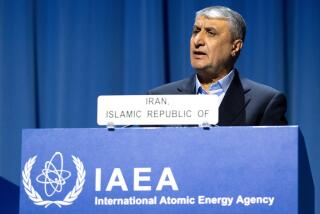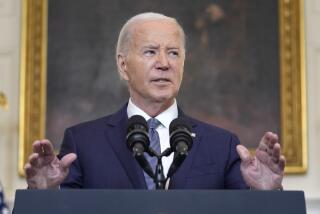The talking — and arguing — points of the Iran nuclear deal
Reporting from Washington — Critics of the Iran nuclear agreement will find much to not like in the deal announced Tuesday. Over the next 60 days, Congress will review the 109-page accord, culminating in a vote of approval or disapproval likely to occur in September. Here’s a look at some of the key criticism and the arguments pro and con likely to be heard in the coming weeks:
Criticism: Rather than halt Iran’s nuclear ambitions, the deal paves a path to an eventual nuclear bomb.
The deal doesn’t force Iran to abandon its nuclear development program, but instead delays it, critics say. Most of the key restrictions on Iran will last 10 to 15 years. “Even before the deal expires, it could allow Iran to develop an industrial-scale enrichment program and continue its R&D on advanced centrifuges,” GOP presidential candidate Jeb Bush said.
Some Democrats agree. “I’m concerned the red lines we drew have turned into green lights; that Iran will be required only to limit rather than eliminate its nuclear program,” said Sen. Robert Menendez (D-N.J.). “The deal doesn’t end Iran’s nuclear program — it preserves it.”
White House response: Officials note that Iran, as a sovereign state, can’t be forever blocked from engaging in any nuclear enrichment. The current agreement will block all four of Iran’s pathways to a bomb for more than 10 years, President Obama says, and will increase the time Iran would need to get a bomb from a couple of months to a year or more.
“We give nothing up by testing whether or not this problem can be solved peacefully,” Obama said. “If, in a worst-case scenario, Iran violates the deal, the same options that are available to me today will be available to any U.S. president in the future. And I have no doubt that 10 or 15 years from now, the person who holds this office will be in a far stronger position with Iran further away from a weapon and with the inspections and transparency that allow us to monitor the Iranian program.”
Criticism: The deal eases sanctions and releases about $100 billion in frozen Iranian assets.
Once the International Atomic Energy Agency verifies that Iran has complied with restrictions on its nuclear development, the country will be able to resume selling oil, rejoin the international financial system and get access to about $100 billion in frozen assets. Critics argue that it took years to impose sanctions that have crippled Iran’s economy and forced its leaders to the negotiating table. Undoing sanctions now will remove that leverage and bolster the clerical government.
“Relieving sanctions would make the Tehran regime flush with cash and could create a more dangerous threat to the United States and its allies,” said Sen. Bob Corker (R-Tenn.), chairman of the Foreign Relations Committee. A growing number of Republicans have suggested that the U.S. should instead retain the current interim deal with Iran and keep sanctions in place until international negotiators can obtain a better deal.
White House response: Under the deal, international sanctions are not lifted but only suspended for 10 years. So if Iran violates the terms, sanctions can “snap back.” Supporters also say the deal may empower more moderate members of Iran’s leadership, who can take credit for the economic improvements brought by sanctions relief.
Obama said that current sanctions could not be maintained indefinitely. “Without this deal, there is no scenario where the world joins us in sanctioning Iran until it completely dismantles its nuclear program,” he said. “Nothing we know about the Iranian government suggests that it would simply capitulate under that kind of pressure. And the world would not support an effort to permanently sanction Iran into submission.”
Criticism: Thousands of Iranian centrifuges will keep spinning.
The deal doesn’t dismantle or close Iran’s two uranium enrichment facilities at Natanz and Fordow. It does require Iran to reduce its centrifuge inventory by two-thirds and eliminate 98% of its stockpile of enriched uranium. Iran will be allowed to keep about 6,100 centrifuges for the next 10 years and continue some enrichment work.
White House response: Iran’s inventory of centrifuges will be cut drastically from nearly 20,000, which is enough to create fuel for as many as 10 bombs. It will be left with only its oldest and least efficient models. No enrichment will be allowed at Fordow, and other activities will be restricted to producing uranium enriched to a level of 3.67%, far below the nearly 90% usually required to make a bomb.
Criticism: No guarantee of “anytime/anywhere” inspections.
Given the level of distrust and Iran’s history of noncooperation, verification is key. Although Iran backed down from its blanket refusal to allow inspections of military sites, critics say the deal still falls short. Inspectors will be allowed to visit any site deemed suspicious, but only after a process that could delay inspection for up to 24 days.
White House response: A 24-day delay is not long enough for Iranians to conceal significant covert operations.
Criticism: The agreement will eventually lift the U.N. conventional arms embargo, a crucial tool for combating Iran’s destabilizing influence and support for terrorism.
Iran will be able to engage in the global arms trade in five years, thanks to a last-minute provision backed by Russia. The embargo on buying or selling ballistic missiles will end in eight, or sooner if inspectors determine that Iran’s nuclear program was peaceful. Lifting the arms embargoes provides Iran a new income stream and also a larger role as a regional player in the Middle East, critics say.
“The result, I fear, is that this agreement will strengthen Iran’s ability to acquire conventional weapons and ballistic missiles, while retaining an industrial-scale nuclear program, without any basic change to its malign activities in the Middle East,” said Sen. John McCain (R-Ariz.).
White House response: Russia and China were pushing for an immediate lifting of the conventional arms embargo. The deal ensures that some restrictions will remain in place for at least five to eight more years and averted a dispute that might have divided the international partners.
Times staff writer Paul Richter in Vienna contributed to this report.
More to Read
Sign up for Essential California
The most important California stories and recommendations in your inbox every morning.
You may occasionally receive promotional content from the Los Angeles Times.











